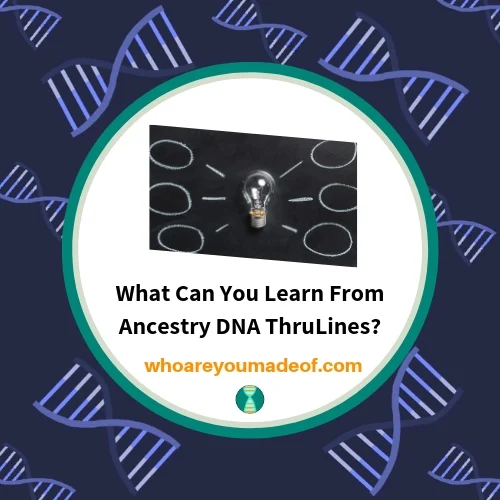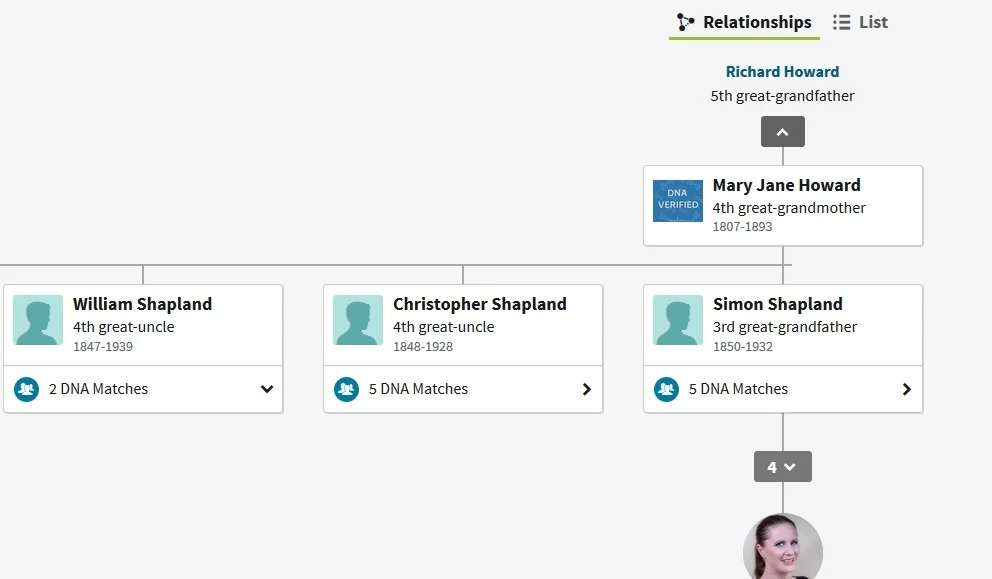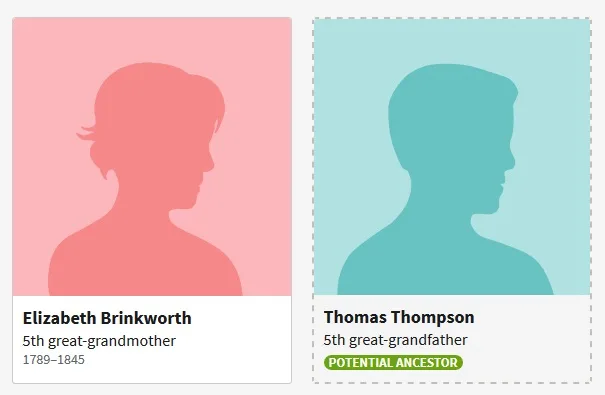Have you checked out the Ancestry DNA ThruLines feature? It is one of the most powerful family research tools currently available, and in this post, I'll explain all that you can learn.
I have thoroughly enjoyed using ThruLines. Using this amazing feature, I have discovered how dozens of my DNA matches are related to me. I've also been able to add more ancestors and relatives to my family tree.

Whether you are interested in building your tree further back or want to know more about your connection with living DNA relatives, you'll find that the ThruLines tool on Ancestry can help you.
What are Ancestry ThruLines?
Ancestry DNA released their ThruLines feature in early 2019. This tool promises to make determining connections with DNA matches easier than ever.
Before Ancestry DNA ThruLines, the only way to figure out how I was related to my DNA matches that only had small trees was to build a small tree for them myself. It was never a big, thorough tree - just a bare "quick and dirty" family tree.
But still, it took a lot of time. There was no better way.
I would use the names of their parents and grandparents to build out the tree until I identified our common ancestor. Sometimes, I was able to do this in just a few minutes. Other times, it took much longer.
Occasionally, I would give up on my match's tree (as they had, too, no doubt) and never learn exactly how we were related.
As you might know, Ancestry has the largest collection of family trees on the internet. How many?
There are at least 100 million family trees hosted on Ancestry.com. This is an incredible source of information, and it is too much for an individual (me!) to effectively process and sort for my own uses.
Ancestry DNA's ThruLines's feature comes to the rescue, essentially analyzing the tens of millions of family trees on the site and comparing them with the trees of my DNA matches.
Their software is able to draw conclusions and fill in blanks, just as I would, in order to figure out how I am related to many of my DNA matches.
ThruLines can help you see connections with DNA matches
As I mentioned before, the primary function of ThruLines is to help us learn how we are likely connected with our DNA matches.
In this part of the post, I'll walk you through a few examples of my own ThruLines so you can see what you might be able to learn from yours.

In the image above, you can see my ThruLine for my great-great-great-great grandmother, Mary Jane Howard. She had several children, and three of them are mentioned in the ThruLine.
One of her sons was named Simon Shapland, who is my great-great-great grandfather. I have five DNA matches who are also descended from Simon.
Simon had two brothers named William and Christopher. I can see that I have two DNA matches who are descended from William and five who are descended from Christopher.
If I click on the down arrows right next to the number of DNA matches descended from my ancestor's siblings, I can see the names of my DNA matches, their calculated relationship to me (based on our genealogical relationship), as well as the amount of DNA that we share.
I can then add these matches and the other individuals who are descended from my ancestor's siblings to my family tree, as well as make notes on their profile. Knowing their relationship to me can also help me figure out how I am related to matches that we share in common.
These DNA matches are related to me through siblings of my ancestors. By adding these DNA matches who are connected on collateral lines of my tree, I can have a more complete understanding of my ancestry and who my living relatives are.
What are ThruLines Potential Ancestors?
The other major bit of information that ThruLines can help us discover are potential ancestors. These are people who are not currently in our family tree, but may be in the trees of others who are DNA matches to us or in trees of other family trees on Ancestry.
How to see potential ancestors on ThruLines
Occasionally, you might spot a ThruLine that has a dotted line around the person's name. This person is someone who Ancestry DNA has identified as a potential ancestor.
In the image below, you can see one person who is already in my tree (solid line) and one person who is not in my tree but might be my ancestor:

I may or may not be descended from "Thomas Thompson", but I think it is worth investigating.
Are Ancestry ThruLines accurate?
While I am a (huuuuge!) fan of Ancestry DNA ThruLines, there is one important thing to remember about this feature. The results, or the output, is only as accurate as the inputs.
Since the ThruLines feature is based on the family trees of people just like you and me, errors are possible. In other words, if the underlying data is incorrect, the ThruLines could be incorrect, too.
In my own experience, ThruLines appear to be very accurate, but it is important to double-check the information that you learn on ThruLines in order to confirm.
For example, if you have a ThruLine that shows that you are related to a DNA match as a fourth cousin twice-removed because they are descended from a sibling of your great-great grandparent, you can try to find records that support this conclusion.
You might find a birth record that names your great-great-great grandparent as the parents of your DNA match's great-great grandparent. Alternatively, you might find the entire family listed on a census record. All of these data points can help you decide if the ThruLine information for your ancestor is correct.
Big data is powerful, but there is no fool-proof substitute for thorough genealogical research!
Is ThruLines better than DNA Circles?
The Ancestry DNA ThruLines has now become the highlight of Ancestry DNA results, and the DNA Circle feature was phased out a few years ago. The technology behind ThruLines is more advanced and accurate than DNA Circles.
If you remember your DNA Circleswere (or are) a fan of them, you might wonder about the differences between the two. The information you can learn seems similar, so which is better? How are the features different?
Advantages of ThruLines vs. DNA Circles
The main advantage of ThruLines over DNA Circles highlights the power of the new Ancestry DNA feature:
DNA matches can show up in your ThruLines even if your common ancestor isn't in their family tree, and even if they only have one or two generations of ancestors in their tree.
As I mentioned in the section above, Ancestry is able to use information gleaned from the 100+ million family trees on the site in order to automatically "build" the family tree of your DNA match and include them in your ThruLines.
There are other advantages to using ThruLines over DNA Circles:
- ThruLines show potential ancestors, not just ancestors who are already in your tree
- ThruLines are presented in a very easy to understand manner
- Information about your DNA match and your calculated relationship are displayed without having to click through to other screens
ThruLines include ancestors who are in your tree and potential ancestors who aren't. DNA Circles include only those who are.
An important feature of DNA Circles that was not included in ThruLines is that there are people in your DNA Circles that don't show up as DNA matches. Your DNA Circles include people who are descended from the same common ancestor and are matches to your DNA matches, as well as people who are DNA matches to you.
(Read more about why we don't share DNA with all of our relatives)
Conclusion
I hope that this post has helped you understand more about Ancestry DNA ThruLines and how they can help you learn more about your family tree.
If you have any questions about something that you read in this post, I would encourage you to join us in the discussion below.
Thank you so much for being here today!


Terri Rumsey
Monday 12th of September 2022
I've always been told my grandfather was adopted. His parents and their lineage are presented as potential ancestors based on other's tree information, but I never linked them to my tree because I assumed they were not biological. Strange thing is that I am now have multiple dna thru line matches to my several of my great grandfather's ancestors indicating that something is amiss. I now believe my great grandfather was the biological father (out of wedlock) of my grandfather and possibly one other child (girl) and subsequently raised by my grandfather and his wife. Through record research, I believe I've identified the biological mother of my grandfather and his younger sister; however no birth records exist. Of course no one is alive to verify this, so I'm wondering how certain I can be of this story?